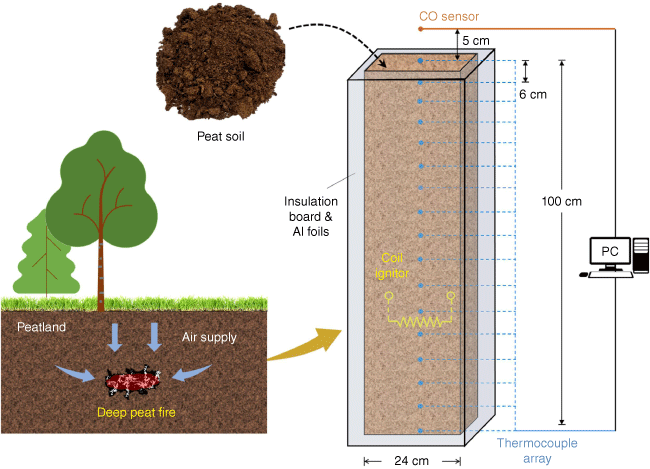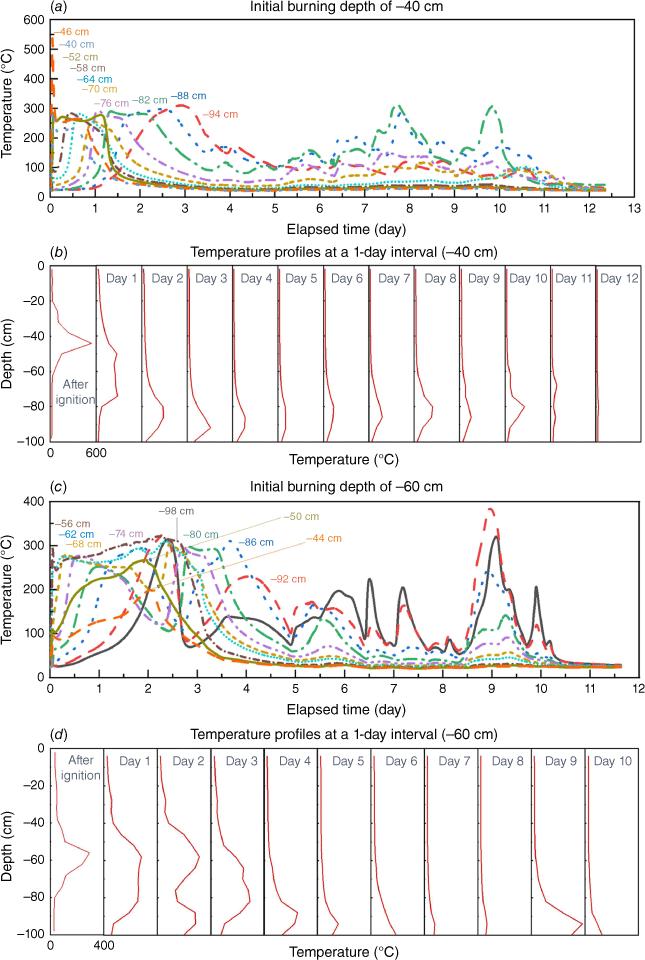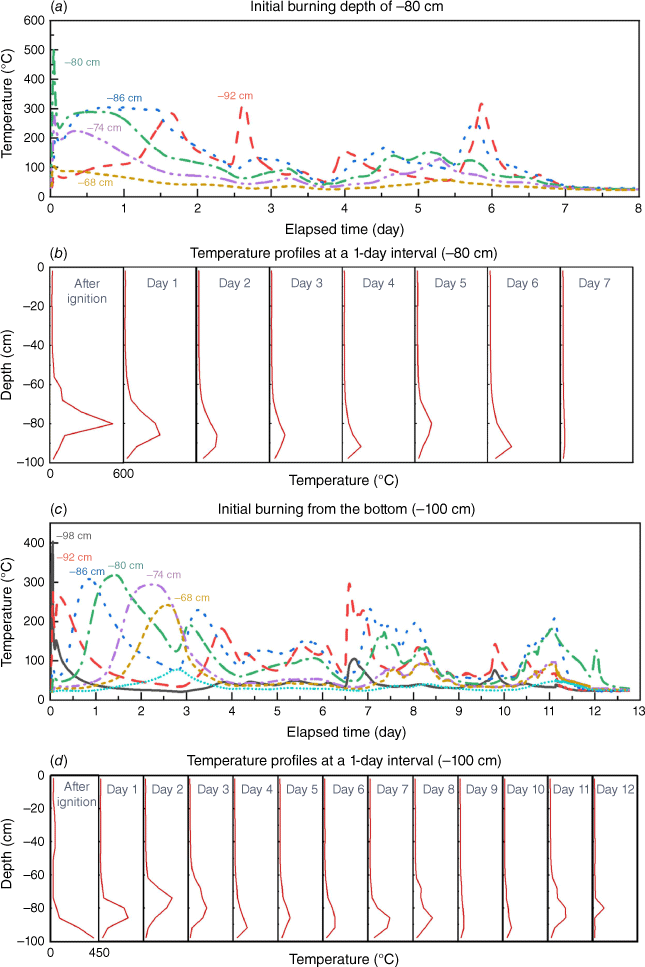Deep peat fire persistently smouldering for weeks: a laboratory demonstration
Yunzhu Qin A B , Dayang Nur Sakinah Musa C D , Shaorun Lin
A B , Dayang Nur Sakinah Musa C D , Shaorun Lin  A B * and Xinyan Huang
A B * and Xinyan Huang  A *
A *
A Research Centre for Fire Safety Engineering, Department of Building Environment and Energy Engineering, The Hong Kong Polytechnic University, Kowloon, Hong Kong.
B The Hong Kong Polytechnic University Shenzhen Research Institute, Shenzhen, China.
C Department of Chemical and Environmental Engineering, Faculty of Engineering, Universiti Putra Malaysia, Malaysia.
D International Tropical Forestry Programme, Faculty of Tropical Forestry, Universiti Malaysia Sabah, Malaysia.
International Journal of Wildland Fire 32(1) 86-98 https://doi.org/10.1071/WF22143
Submitted: 4 July 2022 Accepted: 17 November 2022 Published: 7 December 2022
© 2023 The Author(s) (or their employer(s)). Published by CSIRO Publishing on behalf of IAWF. This is an open access article distributed under the Creative Commons Attribution-NonCommercial-NoDerivatives 4.0 International License (CC BY-NC-ND)
Abstract
Background: Peatlands are becoming more vulnerable to smouldering fires, driven by climate change and human activities.
Aims: This work explores the persistent burning, propagation, and emission of the deep peat fire.
Methods: Laboratory experiments are conducted with a 1-m deep peat column, and smouldering fires are initiated at different depths.
Key results: We found localised burning and multi-directional smouldering fire spread in deep peat layers. The smouldering temperature first decreases with depths up to −40 cm (from around 550 to 350°C) and then remains at about 300°C in the deeper layers. High moisture content can slow down in-depth fire propagation and reduce the burning duration.
Conclusions: Peat fire can burn in deep layers for weeks, and its combustion is incomplete with small mass loss, because of a limited oxygen supply and low smouldering temperature. Measuring the carbon monoxide concentration near the surface can detect underground fire and monitor its intensity.
Implications: This work helps reveal the underlying mechanism of the in-depth smouldering wildfires in peatland and supports future larger-scale peat fire experiments in the field.
Keywords: burning duration, fire detection, fire emissions, fuel mass loss, peat soil, peatland wildfire, smouldering propagation, underground fire.
Introduction
Peat, as a carbon-rich organic soil, accumulates a considerable amount of incompletely decomposed vegetation residues under anaerobic conditions (Page et al. 2002; Hugron et al. 2013). Peatlands are essential terrestrial carbon pools, storing one-third of the world’s soil carbon (500–600 Gt C), as much carbon as surface vegetation globally, and may be of similar magnitude to the atmospheric carbon pool (~850 Gt C) (Ballhorn et al. 2009; Turetsky et al. 2015). Peat is also a porous and charring natural fuel that is prone to smouldering fire. Smouldering fire is slow, low-temperature and flameless, and one of the most persistent types of combustion phenomena (Rein 2013) (Fig. 1a, b). Due to climate change and human activities, peatlands are more prone to large-scale fires than ever before (Jolly et al. 2015; Witze 2020; Lin et al. 2021b). Over the past few decades, frequent peat fires have caused severe ecological and climatic damage, as well as significant economic losses (Mack et al. 2011; Jolly et al. 2015; Turetsky et al. 2015). For example, in 2019, slash-and-burn activities in Southeast Asia resulted in mega-scale peatland wildfires that burned for several months, leading to severe cross-border air pollution and many health issues for the nearby residents (Normile 2019; Goldstein et al. 2020).
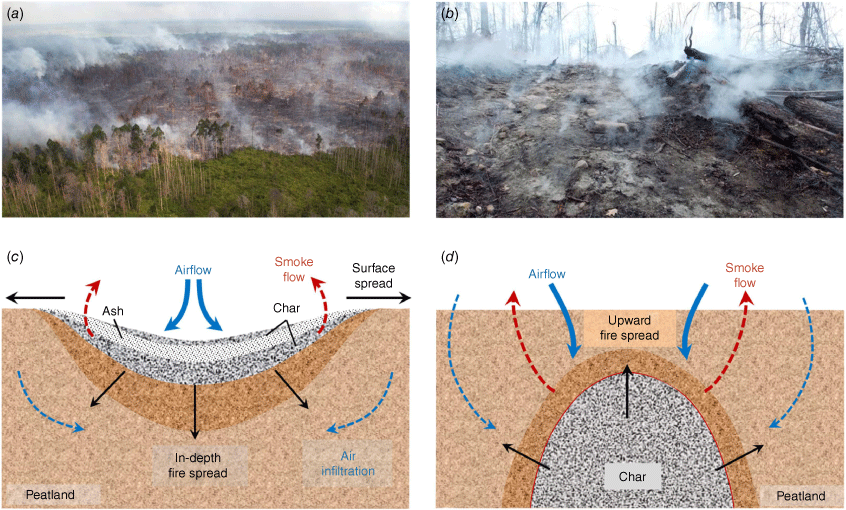
|
Peat can hold a high moisture content that can prevent ignition, but natural and anthropogenic-induced droughts can dramatically increase the risk of peat fire (Sinclair et al. 2020). Similarly, the ignition of peat fire can also be triggered by natural (e.g. lightning (Anderson 2002; Zhang et al. 2021), flaming wildfire (Lin et al. 2019), self-heating ignition (Restuccia et al. 2017) and volcanic eruption (Svensen et al. 2003) or man-made reasons (e.g. deforestation (Silva et al. 2021), poor land management (Dickinson and Ryan 2010), accidental ignition and arson (Prestemon and Butry 2005). In general, smouldering requires less ignition energy than flaming combustion and can persist under wetter and lower-oxygen conditions (Huang and Rein 2016; Lin et al. 2019; Qin et al. 2022), and once ignited, it can propagate vertically and horizontally to expand the burning area rapidly (Fig. 1c) (Huang and Rein 2019). These fires can burn for months or even years, despite extensive rain, weather changes or firefighting operations, thus sustaining the largest and most persistent fire on Earth (Rein 2013; Santoso et al. 2022).
When the rainy season arrives or substantial firefighting operations take effect, even though near-surface smouldering fires could be extinguished, hidden underground smouldering hotspots may still sustain at a low temperature and spread at a very low propagation rate that is extremely difficult to be detected by human patrols and satellite imaging (Rein 2013; Rein and Huang 2021). With the advent of the dry and hot season, the soil on the surface gradually dries, and deep smouldering spots begin to spread towards the ground and flare up, forming a new fire point (Fig. 1d) (Huang and Rein 2019; McCarty et al. 2020). This recurrent fire behaviour has been observed in the peatlands of Southern Africa, Southeast Asia and even the Arctic region (Gumbricht et al. 2002; Rein 2013; Scholten et al. 2021; Santoso et al. 2022). However, such holdover and hibernation behaviours of deep peat fire in global peatlands are still poorly understood, so we need to explore the underlying mechanism and the limiting conditions of these persistent in-depth peat fires.
Past studies have investigated the dynamics of smouldering peat fires, including heterogeneous chemical kinetics (Huang and Rein 2014), ignition (Frandsen 1987, 1997; Restuccia et al. 2017; Lin et al. 2019), fire spread (Huang et al. 2016; Prat-Guitart et al. 2016a; Huang and Rein 2017, 2019; Yang and Chen 2018), extinction (Lin et al. 2021a; Santoso et al. 2021; Mulyasih et al. 2022) and fire emissions (Rein et al. 2009; Hu et al. 2018, 2019). For downward smouldering spread, small-scale lab experiments have demonstrated that fire can spread to a depth of about 30 cm (Benscoter et al. 2011; Huang and Rein 2017). Airborne LIDAR measurement showed that real peat fire could spread down to a depth of 50 cm and last for a long period (Ballhorn et al. 2009).
Our previous small-scale pilot experiments showed that smouldering peat fires could be ignited by a coil heater at a depth of up to 15 cm and then spread upward to the surface (Huang and Rein 2019). During the in-depth burning and upward fire spread process, no visible smoke plume or soil volume change was observed until the fire front reached the ground surface, indicating the difficulty of detecting deep peat fires visually. So far, there is a lack of both lab- and field-scale research to reveal the in-depth smouldering propagation behaviour. Moreover, no large experiment has been conducted to explore smouldering fire behaviour at soil layers deeper than 30 cm.
This study conducts a series of laboratory experiments on 1-m-tall peat columns to explore underground peat fire behaviours. We also quantify the temperature profile, spread dynamics, persistence, and carbon monoxide (CO) emissions of deep peat fires that burn for more than 10 days. This work helps reveal the underlying mechanism of the in-depth smouldering wildfires in peatland and supports future larger-scale peat fire experiments in the field.
Experimental methods
Peat sample
Commercial moss peat soil from Estonia was chosen for this study. This peat had a high organic content (~97%), a uniform density, and a homogenous particle size, thus ensuring high repeatability of experiments, as demonstrated in our previous works (Lin et al. 2019, 2020, 2021a, 2021b; Lin and Huang 2020). Elemental analysis shows that its mass fraction of C/H/O/N/S is 45.6/6.0/48.0/0.5/0.3%, respectively. Before the tests, the peat soil was first dried in an oven at 75°C for 48 h (Huang and Rein 2017). Afterwards, the dried peat was stored in the ambient, so it absorbed air moisture and eventually reached a new equilibrium with a low moisture content (MC) of ~10%, defined as air-dried peat. The measured bulk density (ρp, kg m−3) of air-dried peat was 128 ± 10 kg/m3, and its porosity (Φp) was 0.90 ± 0.01.
To investigate the moisture effect, the oven-dried peat was well mixed with water and left in sealed boxes for homogenisation for at least 48 h. For example, 1.5 kg of 50% MC peat sample required 1 kg of oven-dried peat and 0.5 kg of water. Note that the volume of the peat sample tended to expand naturally during the water-absorbing process, which was also observed in our previous works (Huang and Rein 2017; Lin et al. 2019). The thermogravimetric analysis (TGA) of the peat sample was conducted with a PerkinElmer STA 6000 in both air and nitrogen atmospheres, and the representative data are shown in Appendix 1. The physical and chemical properties of the peat sample are also summarised in Table 1.
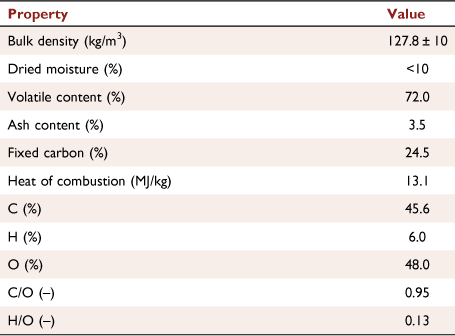
|
Experimental setup and procedure
Fig. 2 shows the schematic diagram of the experimental setup. To better study and observe deep peat fire, the height of the test setup was designed to be 100 cm, larger than all previous laboratory experiments. The test setup was built of 1 cm-thick insulation ceramic fibreboards due to its low conductivity and non-flammability (Christensen et al. 2019), and the top was open to allow oxygen diffusion from the ambient. Similar setups of smaller sizes had been widely used for past lab-scale peat fire experiments (Benscoter et al. 2011; Huang et al. 2016; Prat-Guitart et al. 2016b; Huang and Rein 2017, 2019; Depci and Karta 2018; Christensen et al. 2019; Lin et al. 2021b). Two layers of aluminium foil were attached to the outer surface of the insulation board to seal the reactor and reduce the radiative heat loss due to its lower emissivity (Incropera 2007). The test setup had a large internal cross-section of 24 cm × 24 cm to avoid quenching by the cold wall (Lin and Huang 2021; Lin et al. 2021a, 2022). Together with the ceramic insulation and aluminium foil, the wall cooling was minimised and similar to the field condition. However, the use of ceramic fibreboard makes it impossible for the infrared camera to capture the evolution and propagation of the smouldering front from the side view.
To limit the conductive cooling effect through inserted thermocouples on the smouldering temperature and reactions, the spacing and number of thermocouples were carefully optimised. An array of 17 K-type thermocouples with a bead diameter of 1.5 mm was inserted into the reactor from the side wall at an interval of 6 cm, so they could monitor the temperature and trace the position of the smouldering front. A 20-cm long electrical coil ignitor was inserted into the peat sample at different depths to initiate the smouldering combustion. A Testo 340 real-time emission sensor was installed 5 cm above the original top free surface to measure the CO emission during the smouldering process (note that the top surface might regress during burning). Because of the slow fire propagation and persistence of the burning process, the time interval for recording the in-depth temperature profile and the emission of deep peat fire was set to once per minute.
In order to initiate the peat fire and form a robust smouldering front, the coil ignition protocol was fixed at 200 W for 60 min. Based on past research and preliminary tests, such a heating was strong enough to initiate a uniform smouldering front in a peat sample of MC <150% (Huang and Rein 2017). By placing the coil ignitor at different heights at an interval of 20 cm from the top free surface (0 cm) to the bottom (−100 cm), the smouldering front can be formed at different depths and free to propagate vertically. The tests were stopped if all peat temperature measures had returned to room temperature without a further increase for at least 12 h. For each scenario, tests were repeated at least twice. By lowering the ignition depth, if different fire propagation modes were observed, at least three repeated tests were conducted to ensure repeatability. Our results show excellent repeatability with the use of commercial peat soil with uniform density, particle size and organic content (Lin et al. 2021a).
The air supply to the smouldering peat fire in the experiments was mainly from the top-open surface. There might be tiny gas leakage from the holes that were used to insert the thermocouples, but it was too small to be detected. Nevertheless, in real peat fire scenarios, the oxygen can also infiltrate and diffuse to the smouldering zone from the side, as shown in Fig. 1c, d. Therefore, such weak lateral gas leakages may make the laboratory tests even closer to the actual peat fire in the field.
Results and discussion
Experimental phenomena
The deep-layer underground smouldering fires in peatlands were noticed previously but poorly understood because it is hard to observe the fire phenomena below the surface. This section reports and compares the persistently burning and propagation behaviours of smouldering peat fires (initial MC = 10% for air-dried peat) with different ignition depths. The detailed temperature histories for typical cases are shown in supplementary videos.
Base case with surface ignition
The base case was initially conducted where the smouldering fire was initiated on the surface of the air-dried peat column (MC = 10%; z = 0). Fig. 3a shows the thermocouple measurements of the base case, where the negative signs represent the distances below the initial free surface. After being heated by the electric coil for 60 min, the temperature near the surface exceeded 500°C, suggesting the formation of a robust smouldering front. Afterwards, smouldering spread downward with an obvious surface regression (also see Fig. 3b and Supplementary Video S1a). During the peat fire propagation, a black char layer and a white ash layer were formed below the free surface due to environmental heat losses. Such a phenomenon was also observed in past smaller-scale experiments (Huang and Rein 2017; Lin et al. 2020). As the top ash layer became thicker, the oxygen supply from the top surface to the deeper smouldering front must decrease, so the overall smouldering temperature decreased with the depth from around 550°C to around 350°C (see more discussion in ‘Smouldering temperature’ below).
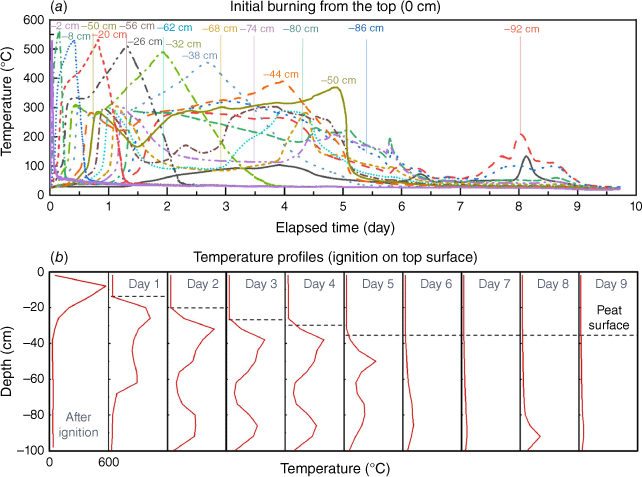
|
After about 4 days, the peak temperature of the smouldering front decreased to about 300°C, which was not strong enough to fully oxidised the char layer (see TGA in Appendix 1). Thus, a lot of unburnt peat and char were left over on the top. After extinction, the top surface no longer regressed and remained at about −35 cm.
For better observation, Fig. 3b further plots the temperature profiles at different moments at a 1-day interval, where the solid red lines represent the temperature profiles, and the dashed black line indicates the position of the top surface after the regression (see original video in Supplementary Video S1a). As expected, after the ignition, a strong smouldering front gradually propagated downward with a regressing top surface. The hottest zone is not on but is consistently below the top free surface, specifically below the generated ash layer. This was because the accumulating layers of unburnt char and ash on the top reduced the environmental cooling (Huang and Rein 2017; Lin and Huang 2021). However, after the initial fast expansion, the smouldering fire front split into two separate burning fronts at different depths. Such a fire phenomenon is observed for the first time.
The primary reason for the separated multi-depth burning was that the downward fire propagation was localised. In other words, the cross-section area of 24 cm × 24 cm was not entirely burnt, considering it was much larger than the thickness of the smouldering front (5–10 cm) (Huang et al. 2016). This is different from previous tests with a smaller cross-section area of 10 cm × 10 cm, where the entire cross-section was ignited and then self-propagated (Huang and Rein 2017; Lin et al. 2020). Herein, some air might bypass the localised shallow fire spot and feed the deeper fire front from the lateral direction. We then expect that the real underground peat fires also split into multiple smouldering fronts and propagate in different directions because of an even greater oxygen supply from various directions. This is why the spread and growth of peat fires in the field are very fast and difficult to predict. Even if all shallow smouldering fires are extinguished, the deep fires may still survive, and it is not easy to detect them.
Moreover, from Fig. 3b and Supplementary Video S1a, we found the deeper smouldering front propagated faster, it first reached the bottom of the reactor on Day 2 and then sustained a weak local burning due to the limited oxygen supply. Afterwards, the second smouldering front continued propagating downward and eventually, two fronts emerged and continued burning for another 4 days. Note that the peak temperature measured on Day 8 was higher than the previous 2 days. This was because the thermocouple measurement was only a point in the axis, and such a point was not in contact with the burning zone on Days 6 and 7. This also proves that the deep smouldering fire front does not cover the whole cross-section area under the limited oxygen supply. The whole burning and propagation process lasted for more than 10 days, showing the persistent and localised smouldering of deep peat fires. After the test, we measured the residual weight and found that only 25% of the total mass was lost in the fire, which was equivalent to burning out a 25-cm thick peat layer. Thus, the burning of deep smouldering peat fire is incomplete, because of limited oxygen supply and low fire temperature.
Afterwards, to simulate the in-depth burning and re-emerging behaviour of peat fires, we initiated smouldering fires at different depths of the peat column (starting from −20 cm) to observe the smouldering burning and fire propagation behaviours.
Shallow peat fire propagation (upward and downward)
Fig. 4a, b shows the temperature evolution of the peat column where the initial burning depth is 20 cm. After forced ignition at z = −20 cm, the smouldering fire front first expanded, as indicated by the thermocouple measurements (also see Supplementary Video S1b). During this process, no smoke or volume change could be observed visually until the expanding smouldering front approached the peat surface. After about 12 h, the smouldering fire re-emerged on the top free surface with heavy smoke and higher temperatures. Then, a black charring spot appeared and expanded laterally, quickly covering the entire top surface under the rich oxygen supply from the ambient. These holdover, hibernation, and re-emerging processes are the same as the observations in past pilot experiments (Huang and Rein 2019) as well as the real fire scenarios in the peatlands of Southern Africa, Southeast Asia and even the Arctic region (Gumbricht et al. 2002; Rein 2013; Scholten et al. 2021). However, once the smouldering front re-surfaced, no flaming fire was ignited because the organic soil was prone to smouldering combustion (Lin et al. 2019). In real fire scenarios, other surface fuels (e.g. leaves and branches) on the peatlands may be ignited or even trigger a flame. This process requires future investigations.
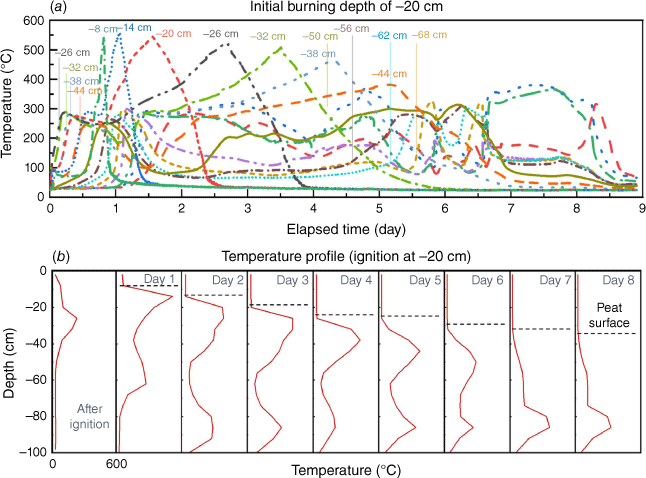
|
Afterwards, the smouldering only propagated downward, and its process was similar to that initiated on the top surface in Fig. 3. During this process, two burning fronts were also observed, and the peat surface also regressed by around 35 cm after persistently burning for 9 days. The observed peak temperatures on Days 7 and 8 are also larger than that on Day 6, because of the localised burning under limited oxygen supply to the deep fire front. In other words, the smouldering fire seems to stay at −80 cm for 6 days, while it may still have local fire spreads toward different directions at that specific depth. To quantify such a multi-directional deep fire propagation we need further investigation with a larger sample or in the field tests.
Deep fire downward propagation
By decreasing the initial burning depth to −40 cm or −60 cm, a different burning phenomenon was observed, as shown in Fig. 5 (also see Supplementary Video S2). After ignition, the smouldering front was persistently burning in the deep peat layer. Above the ignition location, the peat temperature never exceeded 100°C, and the residual was fresh peat. Thus, we can first conclude that there was no upward fire spread.
The peak temperatures below the ignition location barely reached 300°C, which was slightly above the minimum temperature for char oxidation. Nevertheless, we can see the overall fire propagation was downward, and there must be multiple localised fire propagations in different directions. Due to the low smouldering temperature, even after burning for 10 days, the total mass loss was less than 10%. The residual in the deep layer also included some uncharred fresh peat soil. Therefore, the burning of deep peat fire was incomplete, which is another reason for forming multiple burning fronts in deep layers. These deep local fire fronts were unstable under limited oxygen supply, so they may not always be self-sustained. Moreover, during the entire burning process of 10 days, no visible smoke, noticeable collapse, or surface regression was observed, further demonstrating the difficulty of monitoring these in-depth smouldering peat fires. After the sample was cooled down, we waited for another 3 days, but no further temperature increase was observed.
No fire propagation (local partial burning)
Different fire phenomena were observed by moving the ignition position deeper to −80 cm or −100 cm. As shown in Fig. 6 and Supplementary Video S3, after the forced heating, the temperature of the ignition zone could exceed 400°C, indicating a robust heating and ignition process. After the heating power was off, the temperature could only sustain at about 300°C, close to the minimum smouldering temperature of this kind of peat (Lin et al. 2019). However, the fire was successfully initiated because there was some clear temperature increase from time to time.
Within the first 2–3 days after the ignition, the burning zone slightly expanded, but there was neither apparent upward nor downward fire spread. Afterwards, the burning was only sustained in these small regions, and a clear fluctuation of temperature was also observed over the next several days because of the limited and uneven oxygen supply. Eventually, after about 10 days, all measured temperatures were decreased to ambient, and no regression of the peat column could be observed. By examining the fire residue, we found that all peat above the ignition point was nearly undisturbed. Around and below the ignition zone, most of the peat soil was charred, while not much white ash was observed because of the lack of oxygen to sustain a robust oxidation process.
The overall burning was so weak that it was both a long-term burning process and a prolonged extinction process. Note that moisture re-distribution is also possible as the peat sample is relatively large. A burning zone at the deep layer would evaporate the available water in the peat, which is potentially re-condensed in the upper layer. As a result, the moisture content of the upper peat layer may increase and protect the unburnt region, which contributes to the self-suppression of the smouldering fire. More investigations are necessary for future field fire tests.
Smouldering temperature
Fig. 7 summarises the measured peak smouldering temperatures at different burning depths. It is worth noting that the thermocouple, as a point sensor, may not capture the hottest point of the localised smouldering fire front at that depth, so the overall peak temperature may be inevitably underestimated. Therefore, although some measured peak temperatures are lower than 250°C, it does not mean that smouldering can sustain at such a lower temperature (Lin et al. 2019) (see TGA in Appendix 1).
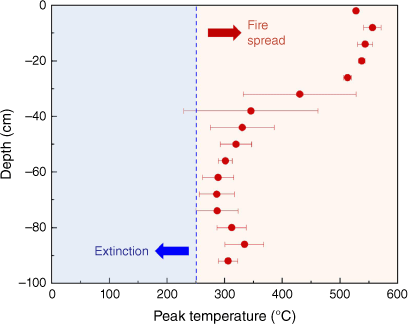
|
For the fire near the surface, the temperature first decreases from about 550–350°C as the location drops from 0 to −40 cm. However, when the smouldering front propagates to be deeper than −40 cm, the peak smouldering temperatures are no longer sensitive to the depth but remain almost stable at around 300°C, which is comparable to the minimum smouldering temperature (Lin et al. 2019).
In general, for the oxygen supply from the top free surface, the smouldering temperature will decrease with depth, because the accumulating char and ash layer on the surface will weaken the oxygen diffusing to the burning area (Huang and Rein 2017). This agrees well with the trend of smouldering temperatures above −40 cm, as shown in Fig. 7. However, as the smouldering fronts locate at a position deeper than −40 cm, the temperatures no longer vary with the depth of the peat column. This may be because the oxygen supply from the top open surface becomes negligible, while lateral oxygen supply starts to dominate when the depth of the smouldering fire is larger than 40 cm. This also explains why the fire ignited below −40 cm only persistently smoulders locally or propagates downward without re-surface to the free ground. In the future, more experimental and numerical investigations will be essential to reveal the underlying mechanisms.
Burnt mass loss
After fire extinction, the residue mass of the 1-m peat column was measured to calculate the total burnt mass loss. For example, if 20% of the mass is lost, it is equivalent to 20 cm being completely burnt out of the total 100 cm thick peat. Fig. 8 shows the mass loss and the equivalent burnt thickness for different initial fire depths. Essentially, the smouldering combustion of deep peat fire is quite incomplete. For ignition on the top surface, only 25% of the original mass is lost, which is reasonable for only 35 cm surface regression (Fig. 3).
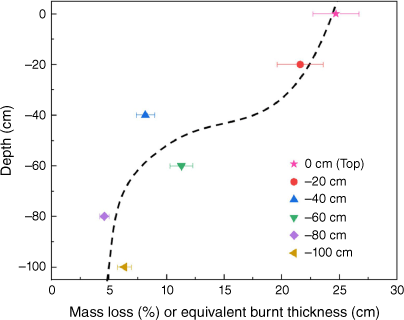
|
For deeper fires, the burning mass loss is less than 10% (equivalent to burning out a 10-cm thick peat layer), where no surface regression or internal collapse was found. Therefore, despite burning for more than 10 days, the burning mass loss is very small, where only a small amount of peat is partially pyrolysed into char. The low in-depth peak temperature (~300°C) indicates only a smaller amount of char is oxidised. As the reaction rate increases exponentially with temperature, burning for a longer duration at a lower temperature does not lead to a large mass loss.
Smouldering CO emission
As smouldering is an incomplete combustion process that generates massive CO, the CO emission is always the quantity of interest as well as an indicator for peat fire (Hu et al. 2018; Lin et al. 2019; Hu and Rein 2022). Therefore, Fig. 9 summarises CO emission concentrations (ppm) at 5 cm above the peat’s (or the reactor’s) initial top surface for smouldering fire ignited at different depths. Although the top surface will clearly regress into the box for the shallow-peat ignition (see Figs. 3 and 4), the emission is relatively confined in the reactor before diluting in the ambient. Thus, the surface regression will not significantly affect the measurement of CO concentration.
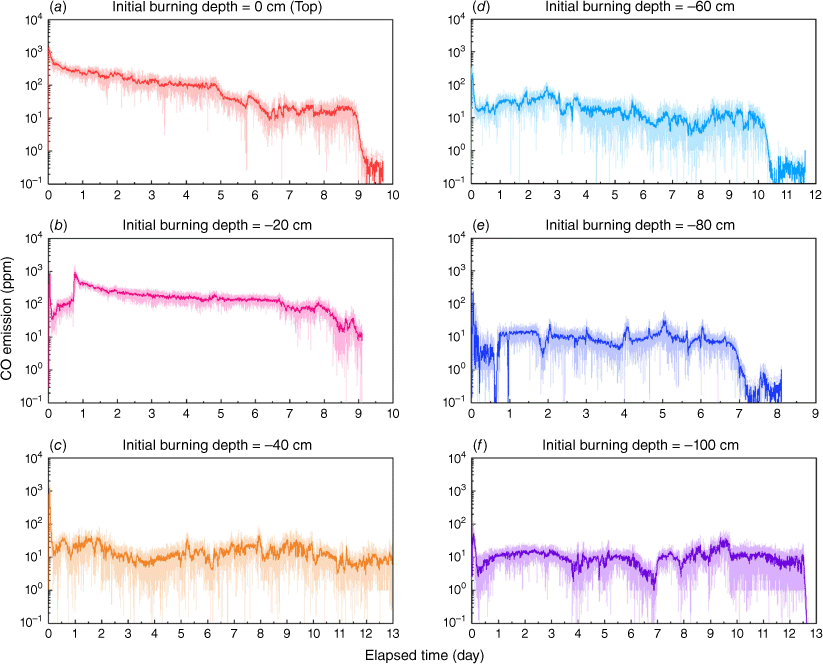
|
During the heating by the coil heater, there was a high level of CO (~103 ppm) for all ignition depths. For initially burning at 0 cm and −20 cm in Fig. 9a, b, the CO concentration is on the order of 102 ppm. The CO concentration continuously increases to 103 ppm during the upward fire spread and following lateral surface spread in Fig. 9b. Note that when the top surface regressed during burning, it also contributed to the decrease of CO concentration.
Such a high CO concentration is a lethal threat to firefighters and nearby residents (Norris et al. 1986; Ernst and Zibrak 1998). Comparatively, for the in-depth smouldering or local burning cases in Fig. 9c–f, the order of the CO concentration decreases to 10 ppm. It is worth noting that even if the in-depth smouldering is extremely difficult to be detected by satellites and patrollers, the CO concentration near the surface remains at a detectable level (>1 ppm). This implies that measuring the CO emission near the peatland surface may be an effective method for detecting deep peat fires.
Effect of moisture content
Moisture content is one of the key parameters that affect the properties of peat soils (Frandsen 1987; Huang and Rein 2017; Dadap et al. 2019; Hu et al. 2019). To investigate the effect of moisture content (MC) on the in-depth burning of the smouldering peat fire, a wetter peat column with 50% MC was also ignited at −60 cm below the top-free surface. Fig. 10 compares the temperature measure between air-dried peat (~10% MC) and wet peat (50% MC), where the burning duration of the wetter peat is significantly reduced. Specifically, as the moisture content increases from ~10 to 50%, the burning duration is decreased by half from about 11 to 5 days.
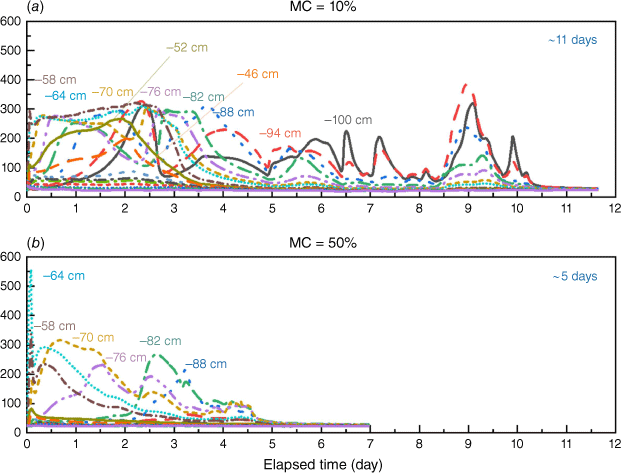
|
Initially, the wet peat (MC = 50%) was able to be ignited with the same ignition protocol (200 W for 60 min). However, the smouldering front only propagated for a short distance to about −80 cm with a decreasing peak temperature. As a result, the burning duration of wet peat is much shorter than that of dry peat, as in Fig. 10. In general, peat moisture has three effects on the deep smouldering fire: (1) altering the thermal properties; (2) increasing heat transfer efficiency through molecular diffusion; and (3) acting as a strong heat sink during evaporation (McAllister et al. 2012; Lin et al. 2019). Also, the evaporated water may re-condense in the upper layer to protect the unburnt region, which contributes to the self-suppression of smouldering fire. This implies the importance of keeping the peat soil moist in regions prone to underground fires. Further explorations on the effects of moisture contents should be conducted thoroughly.
Conclusions
In this work, we experimentally demonstrated that smouldering underground fires could sustain in deep soil layers for more than 10 days, regardless of the initial burning position. As the initial burning position becomes deeper, four smouldering burning modes can be observed: (1) downward propagation; (2) upward-and-downward propagation; (3) in-depth propagation; and (4) no propagation (local partial burning). For the in-depth fire propagation and localised burning, no visual smoke, noticeable collapse, or regression was observed, indicating the difficulty of detecting deep peat fire.
For peat fires shallower than 40 cm, the peak smouldering temperature decreases as the depth increases. For fires deeper than 40 cm, the smouldering temperature remains at about 300°C and becomes insensitive to the depth, revealing the dominant role of lateral oxygen supply in peat fire dynamics in deep soil layers. Despite long-term burning, the mass loss fraction is small (burning out about 10-25 cm thick peat), because the low smouldering temperature causes incomplete combustion. The CO concentration near the surface varies on the order of 10 and 102 ppm, so it can be used to detect underground fires and monitor their intensities. High peat moisture content can slow down in-depth fire propagation and reduce the burning duration. Future work will quantify the oxygen supply to the deep peat fire and establish a computational model to further reveal the smouldering fire under a limited oxygen supply.
Supplementary material
Supplementary material is available online.
Data availability
The data that support this study will be shared upon reasonable request to the corresponding author.
Conflicts of interest
The authors declare that there is no conflict of interest between each other. Dr Xinyan Huang is an Associate Editor of the International Journal of Wildland Fire. To mitigate this potential conflict of interest he was blinded from the review process and was not involved at any stage in the editing of this manuscript.
Declaration of funding
This work is funded by the National Natural Science Foundation of China (No. 51876183).
References
Anderson K (2002) A model to predict lightning-caused fire occurrences. International Journal of Wildland Fire 11, 163–172.| A model to predict lightning-caused fire occurrences.Crossref | GoogleScholarGoogle Scholar |
Ballhorn U, Siegert F, Mason M, Limin S (2009) Derivation of burn scar depths and estimation of carbon emissions with LIDAR in Indonesian peatlands. Proceedings of the National Academy of Sciences 106, 21213–21218.
| Derivation of burn scar depths and estimation of carbon emissions with LIDAR in Indonesian peatlands.Crossref | GoogleScholarGoogle Scholar |
Benscoter BW, Thompson DK, Waddington JM, Flannigan MD, Wotton BM, de Groot WJ, Turetsky MR (2011) Interactive effects of vegetation, soil moisture and bulk density on depth of burning of thick organic soils. International Journal of Wildland Fire 20, 418–429.
| Interactive effects of vegetation, soil moisture and bulk density on depth of burning of thick organic soils.Crossref | GoogleScholarGoogle Scholar |
Christensen E, Hu Y, Restuccia F, Santoso MA, Huang X, Rein G (2019) Experimental methods and scales in smouldering wildfires. In ‘Fire Effects om Soil Properties’. (Ed. P Pereira) pp. 267–280. (CSIRO)
Dadap NC, Cobb AR, Hoyt AM, Harvey CF, Konings AG (2019) Satellite soil moisture observations predict burned area in Southeast Asian peatlands. Environmental Research Letters 14, 094014
| Satellite soil moisture observations predict burned area in Southeast Asian peatlands.Crossref | GoogleScholarGoogle Scholar |
Depci T, Karta M (2018) Peat and lignite leaching process with tetralin in autoclave to produce oil. Physicochemical Problems of Mineral Processing 54, 334–342.
| Peat and lignite leaching process with tetralin in autoclave to produce oil.Crossref | GoogleScholarGoogle Scholar |
Dickinson MB, Ryan KC (2010) Introduction: Strengthening the foundation of wildland fire effects prediction for research and management. Fire Ecology 6, 1–12.
| Introduction: Strengthening the foundation of wildland fire effects prediction for research and management.Crossref | GoogleScholarGoogle Scholar |
Ernst A, Zibrak JD (1998) Carbon monoxide poisoning. New England Journal of Medicine 339, 1603–1608.
| Carbon monoxide poisoning.Crossref | GoogleScholarGoogle Scholar |
Frandsen WH (1987) The influence of moisture and mineral soil on the combustion limits of smoldering forest duff. Canadian Journal of Forest Research 17, 1540–1544.
| The influence of moisture and mineral soil on the combustion limits of smoldering forest duff.Crossref | GoogleScholarGoogle Scholar |
Frandsen WH (1997) Ignition probability of organic soils. Canadian Journal of Forest Research 27, 1471–1477.
| Ignition probability of organic soils.Crossref | GoogleScholarGoogle Scholar |
Goldstein JE, Graham L, Ansori S, Vetrita Y, Thomas A, Applegate G, Vayda AP, Saharjo BH, Cochrane MA (2020) Beyond slash-and-burn: The roles of human activities, altered hydrology and fuels in peat fires in Central Kalimantan, Indonesia. Singapore Journal of Tropical Geography 41, 190–208.
| Beyond slash-and-burn: The roles of human activities, altered hydrology and fuels in peat fires in Central Kalimantan, Indonesia.Crossref | GoogleScholarGoogle Scholar |
Gumbricht T, McCarthy TS, McCarthy J, Roy D, Frost PE, Wessels K (2002) Remote sensing to detect sub-surface peat fires and peat fire scars in the Okavango Delta, Botswana. South African Journal of Science 98, 351–358. https://hdl.handle.net/10520/EJC97510
Hu Y, Fernandez-Anez N, Smith TEL, Rein G (2018) Review of emissions from smouldering peat fires and their contribution to regional haze episodes. International Journal of Wildland Fire 27, 293–312.
| Review of emissions from smouldering peat fires and their contribution to regional haze episodes.Crossref | GoogleScholarGoogle Scholar |
Hu Y, Christensen EG, Amin HMF, Smith TEL, Rein G (2019) Experimental study of moisture content effects on the transient gas and particle emissions from peat fires. Combustion and Flame 209, 408–417.
| Experimental study of moisture content effects on the transient gas and particle emissions from peat fires.Crossref | GoogleScholarGoogle Scholar |
Hu Y, Rein G (2022) Development of gas signatures of smouldering peat wildfire from emission factors International Journal of Wildland Fire 31, 1014–1032.
| Development of gas signatures of smouldering peat wildfire from emission factorsCrossref | GoogleScholarGoogle Scholar |
Huang X, Rein G (2014) Smouldering combustion of peat in wildfires: Inverse modelling of the drying and the thermal and oxidative decomposition kinetics. Combustion and Flame 161, 1633–1644.
| Smouldering combustion of peat in wildfires: Inverse modelling of the drying and the thermal and oxidative decomposition kinetics.Crossref | GoogleScholarGoogle Scholar |
Huang X, Rein G (2016) Interactions of Earth’s atmospheric oxygen and fuel moisture in smouldering wildfires. Science of the Total Environment 572, 1440–1446.
| Interactions of Earth’s atmospheric oxygen and fuel moisture in smouldering wildfires.Crossref | GoogleScholarGoogle Scholar |
Huang X, Rein G (2017) Downward spread of smouldering peat fire: The role of moisture, density and oxygen supply. International Journal of Wildland Fire 26, 907–918.
| Downward spread of smouldering peat fire: The role of moisture, density and oxygen supply.Crossref | GoogleScholarGoogle Scholar |
Huang X, Rein G (2019) Upward-and-downward spread of smoldering peat fire. Proceedings of the Combustion Institute 37, 4025–4033.
| Upward-and-downward spread of smoldering peat fire.Crossref | GoogleScholarGoogle Scholar |
Huang X, Restuccia F, Gramola M, Rein G (2016) Experimental study of the formation and collapse of an overhang in the lateral spread of smouldering peat fires. Combustion and Flame 168, 393–402.
| Experimental study of the formation and collapse of an overhang in the lateral spread of smouldering peat fires.Crossref | GoogleScholarGoogle Scholar |
Hugron S, Bussières J, Rochefort L (2013) ‘Tree plantations within the context of ecological restoration of peatlands: practical guide.’ Peatland Ecology Research Group, Université Laval, Québec. 88 p.
Incropera FP (2007) ‘Principles of heat and mass transfer.’ (John Wiley)
Jolly WM, Cochrane MA, Freeborn PH, Holden ZA, Brown TJ, Williamson GJ, Bowman DMJS (2015) Climate-induced variations in global wildfire danger from 1979 to 2013. Nature Communications 6, 7537
| Climate-induced variations in global wildfire danger from 1979 to 2013.Crossref | GoogleScholarGoogle Scholar |
Lin S, Huang X (2020) An experimental method to investigate the water-based suppression of smoldering peat fire. MethodsX 7, 100934
| An experimental method to investigate the water-based suppression of smoldering peat fire.Crossref | GoogleScholarGoogle Scholar |
Lin S, Huang X (2021) Quenching of smoldering: Effect of wall cooling on extinction. Proceedings of the Combustion Institute 38, 5015–5022.
| Quenching of smoldering: Effect of wall cooling on extinction.Crossref | GoogleScholarGoogle Scholar |
Lin S, Cheung YK, Xiao Y, Huang X (2020) Can rain suppress smoldering peat fire. Science of the Total Environment 727, 138468
| Can rain suppress smoldering peat fire.Crossref | GoogleScholarGoogle Scholar |
Lin S, Sun P, Huang X (2019) Can peat soil support a flaming wildfire. International Journal of Wildland Fire 28, 601–613.
| Can peat soil support a flaming wildfire.Crossref | GoogleScholarGoogle Scholar |
Lin S, Liu Y, Huang X (2021a) How to build a firebreak to stop smouldering peat fire: Insights from a laboratory-scale study. International Journal of Wildland Fire 30, 454–461.
| How to build a firebreak to stop smouldering peat fire: Insights from a laboratory-scale study.Crossref | GoogleScholarGoogle Scholar |
Lin S, Liu Y, Huang X (2021b) Climate-induced Arctic-boreal peatland fire and carbon loss in the 21st century. Science of the Total Environment 796, 148924
| Climate-induced Arctic-boreal peatland fire and carbon loss in the 21st century.Crossref | GoogleScholarGoogle Scholar |
Lin S, Yuan H, Huang X (2022) A computational study on the quenching and near-limit propagation of smoldering combustion. Combustion and Flame 238, 111937
| A computational study on the quenching and near-limit propagation of smoldering combustion.Crossref | GoogleScholarGoogle Scholar |
Mack MC, Bret-Harte MS, Hollingsworth TN, Jandt RR, Schuur EAG, Shaver GR, Verbyla DL (2011) Carbon loss from an unprecedented Arctic tundra wildfire. Nature 475, 489–92.
| Carbon loss from an unprecedented Arctic tundra wildfire.Crossref | GoogleScholarGoogle Scholar |
McAllister S, Grenfell I, Hadlow A, Jolly WM, Finney M, Cohen J (2012) Piloted ignition of live forest fuels. Fire Safety Journal 51, 133–142.
| Piloted ignition of live forest fuels.Crossref | GoogleScholarGoogle Scholar |
McCarty JL, Smith TEL, Turetsky MR (2020) Arctic fires re-emerging. Nature Geoscience 13, 658–660.
| Arctic fires re-emerging.Crossref | GoogleScholarGoogle Scholar |
Mulyasih H, Akbar LA, Ramadhan ML, Cesnanda AF, Putra RA, Irwansyah R, Nugroho YS (2022) Experimental study on peat fire suppression through water injection in laboratory scale. Alexandria Engineering Journal 61, 12525–12537.
| Experimental study on peat fire suppression through water injection in laboratory scale.Crossref | GoogleScholarGoogle Scholar |
Normile D (2019) Indonesia’s fires are bad, but new measures prevented them from becoming worse. Science, 1 October 2019.
| Crossref |
Norris JC, Moore SJ, Hume AS (1986) Synergistic lethality induced by the combination of carbon monoxide and cyanide. Toxicology 40, 121–129.
| Synergistic lethality induced by the combination of carbon monoxide and cyanide.Crossref | GoogleScholarGoogle Scholar |
Page SE, Siegert F, Rieley JO, Boehm H-DV, Jaya A, Limin S (2002) The amount of carbon released from peat and forest fires in Indonesia during 1997. Nature 420, 61–65.
| The amount of carbon released from peat and forest fires in Indonesia during 1997.Crossref | GoogleScholarGoogle Scholar |
Prat-Guitart N, Rein G, Hadden RM, Belcher CM, Yearsley JM (2016a) Effects of spatial heterogeneity in moisture content on the horizontal spread of peat fires. Science of the Total Environment 572, 1422–1430.
| Effects of spatial heterogeneity in moisture content on the horizontal spread of peat fires.Crossref | GoogleScholarGoogle Scholar |
Prat-Guitart N, Rein G, Hadden RM, Belcher CM, Yearsley JM (2016b) Propagation probability and spread rates of self-sustained smouldering fires under controlled moisture content and bulk density conditions. International Journal of Wildland Fire 25, 456–465.
| Propagation probability and spread rates of self-sustained smouldering fires under controlled moisture content and bulk density conditions.Crossref | GoogleScholarGoogle Scholar |
Prestemon JP, Butry DT (2005) Time to Burn: Modeling Wildland Arson as an Autoregressive Crime Function. American Journal of Agricultural Economics 87, 756–770.
| Time to Burn: Modeling Wildland Arson as an Autoregressive Crime Function.Crossref | GoogleScholarGoogle Scholar |
Qin Y, Chen Y, Lin S, Huang X (2022) Limiting oxygen concentration and supply rate of smoldering propagation. Combustion and Flame 245, 112380
| Limiting oxygen concentration and supply rate of smoldering propagation.Crossref | GoogleScholarGoogle Scholar |
Rein G (2013) Smouldering Fires and Natural Fuels. In ‘Fire Phenomena in the Earth System’. (Ed. CM Belcher) pp. 15–34. (John Wiley & Sons, Ltd.: New York)
| Crossref |
Rein G, Huang X (2021) Smouldering wildfires in peatlands, forests and the arctic: Challenges and perspectives. Current Opinion in Environmental Science & Health 24, 100296
| Smouldering wildfires in peatlands, forests and the arctic: Challenges and perspectives.Crossref | GoogleScholarGoogle Scholar |
Rein G, Cohen S, Simeoni A (2009) Carbon emissions from smouldering peat in shallow and strong fronts. Proceedings of the Combustion Institute 32, 2489–2496.
| Carbon emissions from smouldering peat in shallow and strong fronts.Crossref | GoogleScholarGoogle Scholar |
Restuccia F, Huang X, Rein G (2017) Self-ignition of natural fuels: Can wildfires of carbon-rich soil start by self-heating? Fire Safety Journal 91, 828–834.
| Self-ignition of natural fuels: Can wildfires of carbon-rich soil start by self-heating?Crossref | GoogleScholarGoogle Scholar |
Santoso MA, Cui W, Amin HMF, Christensen EG, Nugroho YS, Rein G (2021) Laboratory study on the suppression of smouldering peat wildfires: effects of flow rate and wetting agent. International Journal of Wildland Fire 30, 378–390.
| Laboratory study on the suppression of smouldering peat wildfires: effects of flow rate and wetting agent.Crossref | GoogleScholarGoogle Scholar |
Santoso MA, Christensen EG, Amin HMF, Palamba P, Hu Y, Purnomo DMJ, Cui W, Pamitran A, Richter F, Smith TEL, Nugroho YS, Rein G (2022) GAMBUT field experiment of peatland wildfires in Sumatra: from ignition to spread and suppression. International Journal of Wildland Fire 31, 949–966.
| GAMBUT field experiment of peatland wildfires in Sumatra: from ignition to spread and suppression.Crossref | GoogleScholarGoogle Scholar |
Scholten RC, Jandt R, Miller EA, Rogers BM, Veraverbeke S (2021) Overwintering fires in boreal forests. Nature 593, 399–404.
| Overwintering fires in boreal forests.Crossref | GoogleScholarGoogle Scholar |
Silva CA, Santilli G, Sano EE, Laneve G (2021) Fire occurrences and greenhouse gas emissions from deforestation in the Brazilian Amazon. Remote Sensing 13, 376
| Fire occurrences and greenhouse gas emissions from deforestation in the Brazilian Amazon.Crossref | GoogleScholarGoogle Scholar |
Sinclair AL, Graham LLB, Putra EI, Saharjo BH, Applegate G, Grover SP, Cochrane MA (2020) Effects of distance from canal and degradation history on peat bulk density in a degraded tropical peatland. Science of the Total Environment 699, 134199
| Effects of distance from canal and degradation history on peat bulk density in a degraded tropical peatland.Crossref | GoogleScholarGoogle Scholar |
Svensen H, Dysthe DK, Bandlien EH, Sacko S, Coulibaly H, Planke S (2003) Subsurface combustion in Mali: Refutation of the active volcanism hypothesis in West Africa. Geology 31, 581–584.
| Subsurface combustion in Mali: Refutation of the active volcanism hypothesis in West Africa.Crossref | GoogleScholarGoogle Scholar |
Turetsky MR, Benscoter B, Page S, Rein G, Van Der Werf GR, Watts A (2015) Global vulnerability of peatlands to fire and carbon loss. Nature Geoscience 8, 11–14.
| Global vulnerability of peatlands to fire and carbon loss.Crossref | GoogleScholarGoogle Scholar |
Witze A (2020) The Arctic is burning like never before — and that’s bad news for climate change. Nature 585, 336–337.
| The Arctic is burning like never before — and that’s bad news for climate change.Crossref | GoogleScholarGoogle Scholar |
Yang J, Chen H (2018) Natural Downward Smouldering of Peat: Effects of Inorganic Content and Piled Bed. Fire Technology 54, 1219–1247.
| Natural Downward Smouldering of Peat: Effects of Inorganic Content and Piled Bed.Crossref | GoogleScholarGoogle Scholar |
Zhang H, Qiao Y, Chen H, Liu N, Zhang L, Xie X (2021) Experimental study on flaming ignition of pine needles by simulated lightning discharge. Fire Safety Journal 120, 103029
| Experimental study on flaming ignition of pine needles by simulated lightning discharge.Crossref | GoogleScholarGoogle Scholar |
Appendix 1. Thermogravimetric analysis (TGA)
The peat sample was first pulverised into powders and dried at 90°C for 48 h. The thermal analysis of the peat sample was performed using a PerkinElmer STA 6000 Simultaneous Thermal Analyzer in both air and nitrogen atmospheres. The initial mass was around 2–3 mg, and the sample was heated at a relatively low heating rate of 10 K/min. Fig. A1 shows the remaining mass fraction and mass-loss rate curves of this peat. As expected, the mass-loss rate rapidly increases at about 250°C, which could be defined as the pyrolysis temperature.


